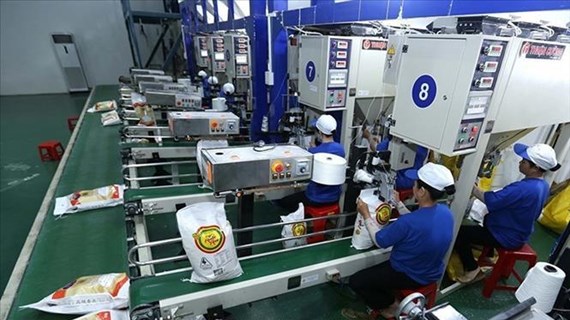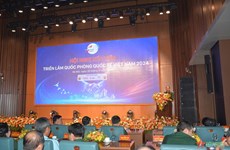Authorities move to expand public transport in cities
Khuat Viet Hung,
director of the Department of Transport, spoke to Nong thon ngay nay
(Countryside today) about a project to develop public transport in
Vietnam's major cities.
Khuat Viet Hung,
director of the Department of Transport, spoke to Nong thon ngay nay
(Countryside today) about a project to develop public transport in
Vietnam's major cities.
* Why was the project titled Limitation on individual vehicles renamed to Appropriate ways to develop transportation forms in Vietnam's big cities?
The previous name caused misunderstandings. The goal of traffic management and development is actually to facilitate safe, economical and eco-friendly transportation. To achieve this, we need to utilise infrastructure and public transport most effectively.
The project is a collection of short-time and medium-term solutions to control traffic. Limiting the numbers of individual vehicles is a solution, not a target.
* How will the solution of limiting individual vehicles be used?
Management of vehicles is one of the four main solutions offered. It helps commuters decide which means of transport will benefit them most. It aims to reduce the percentage of individual vehicles by 20-25 percent by 2020, thus increasing the use of public transport and bicycles.
Individual motorbikes currently account for 80 percent of traffic, and the ratio should be reduced by 55 percent by 2020. To do that, we need to re-arrange traffic flows, organise pedestrian streets, increase public transport - and collect parking fees, which should be high in inner cities and low in outer areas.
Each city will have its own level of private transport. We will not directly prohibit anything because the word "prohibit" creates a negative attitude, but we have solutions instead. For example, we will expand pedestrian streets, which means no vehicles can enter.
* Why was a proposal to collect fees for travelling in the inner city removed?
The proposal was discussed, but due to economic difficulties, was found not to be feasible. The aim of the project is to create lower traffic costs.
Because infrastructure has not been improved, we need to do better in managing what we have now.
* What are the responsibilities of agencies and localities involved in the project?
Inner city traffic is the responsibility of central cities and provinces. The Government is only responsible for creating measures.
In particular, Hanoi and Ho Chi Minh City have to complete the project on controlling individual vehicles and develop bus transport as well as modernising public-transport management centres by 2017. Additionally, two cities will co-operate with the Ministry of Finance to pilot the collection of fees for parking vehicles.
* Many experts doubt the success of the project. How do you evaluate its feasibility?
The solution is feasible because we will not only develop public transport, but also manage individual vehicles. We need to build public transport management centres to control public transpor, as well as giving priority to buses. Other vehicles will have to make ways for buses at peak hours.
The solution has already been implemented and shows signs of working well. Some streets in Hanoi have already prohibited private cars at peak hours and ensured pavement space for pedestrians.-VNA
* Why was the project titled Limitation on individual vehicles renamed to Appropriate ways to develop transportation forms in Vietnam's big cities?
The previous name caused misunderstandings. The goal of traffic management and development is actually to facilitate safe, economical and eco-friendly transportation. To achieve this, we need to utilise infrastructure and public transport most effectively.
The project is a collection of short-time and medium-term solutions to control traffic. Limiting the numbers of individual vehicles is a solution, not a target.
* How will the solution of limiting individual vehicles be used?
Management of vehicles is one of the four main solutions offered. It helps commuters decide which means of transport will benefit them most. It aims to reduce the percentage of individual vehicles by 20-25 percent by 2020, thus increasing the use of public transport and bicycles.
Individual motorbikes currently account for 80 percent of traffic, and the ratio should be reduced by 55 percent by 2020. To do that, we need to re-arrange traffic flows, organise pedestrian streets, increase public transport - and collect parking fees, which should be high in inner cities and low in outer areas.
Each city will have its own level of private transport. We will not directly prohibit anything because the word "prohibit" creates a negative attitude, but we have solutions instead. For example, we will expand pedestrian streets, which means no vehicles can enter.
* Why was a proposal to collect fees for travelling in the inner city removed?
The proposal was discussed, but due to economic difficulties, was found not to be feasible. The aim of the project is to create lower traffic costs.
Because infrastructure has not been improved, we need to do better in managing what we have now.
* What are the responsibilities of agencies and localities involved in the project?
Inner city traffic is the responsibility of central cities and provinces. The Government is only responsible for creating measures.
In particular, Hanoi and Ho Chi Minh City have to complete the project on controlling individual vehicles and develop bus transport as well as modernising public-transport management centres by 2017. Additionally, two cities will co-operate with the Ministry of Finance to pilot the collection of fees for parking vehicles.
* Many experts doubt the success of the project. How do you evaluate its feasibility?
The solution is feasible because we will not only develop public transport, but also manage individual vehicles. We need to build public transport management centres to control public transpor, as well as giving priority to buses. Other vehicles will have to make ways for buses at peak hours.
The solution has already been implemented and shows signs of working well. Some streets in Hanoi have already prohibited private cars at peak hours and ensured pavement space for pedestrians.-VNA












